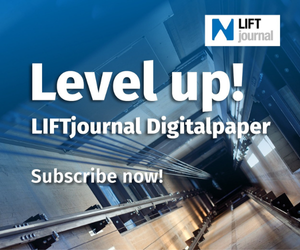How unsuitable screw locking devices influences structure-borne emissions
The decisive factor for lifts without machine rooms and synchronous drives is the transmission of structure-borne sound to rooms requiring protection.
Where oscillation insulation is used, steps must be taken through suitable screw locking devices to ensure the pretensioning of the screw fittings is not reduced.
Measurements of structure-borne noise emissions on the lift shaft wall according to DIN 8989 indicate that changes in the pretensioning force of screw connections have a direct influence on an increased noise level in rooms requiring protection.
Structure-borne noise or oscillation measurements on lifts or their components have revealed that the pretensioning force of screw connections is reduced over their service life if unsuitable screw locking devices are used.
Loss of pretensioning force
Screw connections subject to stress in lift construction and the attachment of lift components fail when they come loose on their own during operation. Independent loosening of screw connections is equivalent to complete or partial loss of pretensioning force. This loss greatly increases structure-borne sound emissions in the lift shaft wall and can result in permanent fracture of the screw.
Particularly in the case of separation joints – for example, in the case of oscillation insulation, axial loads, eccentric operationally-stressed screw connections – insufficient pretensioning force can produce a system change in screws and stressed parts, which can in turn result in unexpected overloading of screw and nut.
Experiments employing growing axial tensile loading have identified partial loosening of screw connections. Loosening of the screw connection is due to reduction in the friction grip as a result of radial sliding movements between the thread flanks (screw-nut). In 2003, a series of standards regarding locking elements were withdrawn, which were assigned to the categories "mechanical locking devices" and "anti-settling locks" or were in practice incorrectly assigned to them (see box below).
Effective locking measures
According to DIN 820-1, standards must take the state of the art into account. This was no longer the case for the above-mentioned standards, which made their withdrawal essential.
The task of fasteners or locking measures against loosening of screw connections is to keep the decline in pretensioning force produced by the settling and/or creeping to be expected as small as possible. This is usually facilitated by increasing the compliance of screws and/or tensioned parts.
Mechanical locking devices prevent independent loosening even in the case of extremely dynamic loads; they maintain at least 80 percent of the original pretensioning force in the screw connection. Effective locking measures are for example screws, nuts or washers with locking teeth or locking ribs (e.g. Ripplock).
Bonding in the thread
Screws, nut and discs featuring such structures in the bearing surface are currently not standardised. Another effective way of preventing loosening is bonding in the thread for which microencapsulated adhesives (DIN 267-27) or anaerobic hardening liquid adhesives are suitable (DIN EN ISO 10123).
Changes in the position of the car through a reduction in the pretensioning force of screws have a significant effect on structure-borne noise emissions via the drive and/or rail attachments into the lift shaft wall.
Oscillation insulation, which was improperly or unprofessionally designed (e.g. according to DIN EN 1299) and defective screw fastenings will fail to meet the structure-borne noise targets of DIN 8989.
Ulrich Nees
aufzugsystemeberatung.de
These locking element standards were withdrawn in 2003:
– Lock washers according to DIN 128 and DIN 6905
– Spring washers according to DIN 137 and DIN 6904
– Serrated lock washers according to DIN 6798 and DIN 6907
– Toothed lock washers according to DIN 6797
– Tab washers according to DIN 93, DIN 432 and DIN 463
– Screw safety cups according to DIN 526
– Self-locking nuts according to DIN 7967





















Write a comment